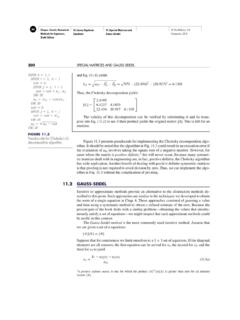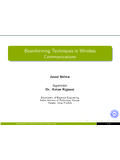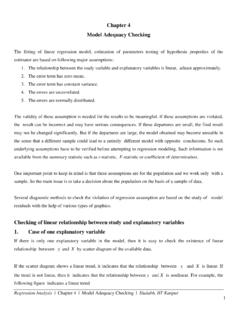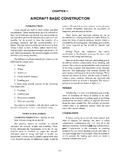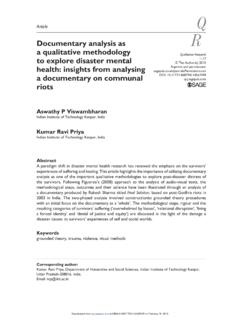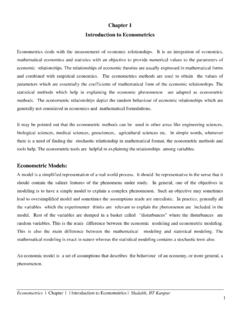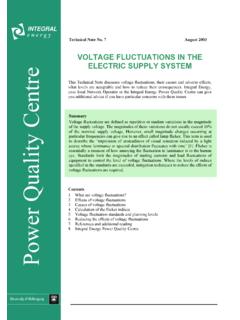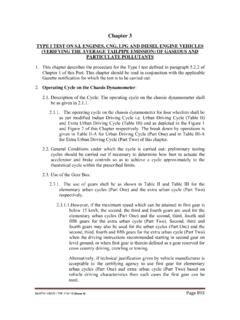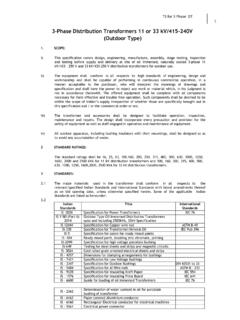Transcription of Notes on Power System Voltage Stability - IIT Kanpur
1 1 Notes on Power System Voltage Stability By S. Chakrabarti, Dept. of EE, IIT, Kanpur 1. Power System Voltage Stability At any point of time, a Power System operating condition should be stable, meeting various operational criteria, and it should also be secure in the event of any credible contingency. Present day Power systems are being operated closer to their Stability limits due to economic and environmental constraints. Maintaining a stable and secure operation of a Power System is therefore a very important and challenging issue. Voltage instability has been given much attention by Power System researchers and planners in recent years, and is being regarded as one of the major sources of Power System insecurity. Voltage instability phenomena are the ones in which the receiving end Voltage decreases well below its normal value and does not come back even after setting restoring mechanisms such as VAR compensators, or continues to oscillate for lack of damping against the disturbances.
2 Voltage collapse is the process by which the Voltage falls to a low, unacceptable value as a result of an avalanche of events accompanying Voltage instability [1]. Once associated with weak systems and long lines, Voltage problems are now also a source of concern in highly developed networks as a result of heavier loading. The main factors causing Voltage instability in a Power System are now well explored and understood [1-13]. A brief introduction to the basic concepts of Voltage Stability and some of the conventional methods of Voltage Stability analysis are presented in this chapter. Simulation results on test Power systems are presented to illustrate the problem of Voltage Stability and the conventional methods to analyze the problem. Limitations of conventional methods of Voltage Stability analysis are pointed out and the scope of the use of Artificial Neural Networks as a better alternative is discussed.
3 2. Classification of Voltage Stability The time span of a disturbance in a Power System , causing a potential Voltage instability problem, can be classified into short-term and long-term. The corresponding Voltage Stability dynamics is called short- term and long-term dynamics respectively [2-5]. Automatic Voltage regulators, excitation systems, turbine and governor dynamics fall in this short-term or transient time scale, which is typically a few seconds. Induction motors, electronically operated loads and HVDC interconnections also fall in this category. If the System is stable, short-term disturbance dies out and the System enters a slow long-term dynamics. Components operating in the long-term time frame are transformer tap changers, limiters, boilers etc. Typically, this time frame is for a few minutes to tens of minutes.
4 A Voltage Stability problem in the long-term time frame is mainly due to the large electrical distance between the generator and the load , and thus depends on the detailed topology of the Power System . Figure shows the components and controls that may affect the Voltage Stability of a Power System , along with their time frame of operation [1]. Examples of short-term or transient Voltage instability can be found in the instability caused by rotor angle imbalance or loss of synchronism. Recent studies have shown that the integration of highly stressed HVDC links degrades the transient Voltage Stability of the System [1]. 2 Figure : Time responses of different controls and components to Voltage Stability [1] There is not much scope for operator intervention in transient Voltage instability. The transmission System operator (TSO) mainly relies on automatic emergency actions to avoid incumbent Voltage instability.
5 The automatic corrective actions are taken through protective devices to preserve operation of largest possible part of the Power System by isolating the unstable part [6]. Long-term Voltage instability (or mid-term or post-transient, as it is sometimes called) problems can occur in heavily loaded systems where the electrical distance is large between the generator and the load . The instability may be triggered by high Power imports from remote generating stations, a sudden large disturbance, or a large load buildup (such as morning or afternoon pickup). Operator intervention may be possible if the time scale is long enough. Timely application of reactive Power compensation or load shedding may prevent this type of Voltage instability. 3 From the point of view of techniques used to analyze the Voltage Stability , it is often useful to categorize the problem into small-disturbance and large-disturbance Voltage Stability [2].
6 Small disturbance or steady state Voltage Stability deals with the situation when the System is subjected to a small perturbation, such that the System can be analyzed by linearizing around the pre-disturbance operating point. Steady state Stability analysis is helpful in getting a qualitative picture of the System , , how stressed the System is, or how close the System is, to the point of instability. Examples of steady state Stability can be found in Power systems experiencing gradual change in load . Large-disturbance Stability deals with larger disturbances such as loss of generation, loss of line etc. To analyze the large-disturbance Stability , one has to capture the System dynamics for the whole time frame of the disturbance. A suitable model of the System has to be assumed and a detailed dynamic analysis has to be carried out in order to get a clear picture of the Stability .
7 3. Voltage Stability of a simple 2-bus System The basic concept of Voltage Stability can be explained with a simple 2-bus System shown in Figure The load is of constant Power type. Real Power transfer from bus 1 to 2 is given by [4], EVPsinX= ( ) Reactive Power transfer from bus 1 to 2 is given by, 2V EVQcosX X= + ( ) where, E= E is the Voltage at bus 1, V 0= Vis the Voltage at bus 2, X= impedance of the line (neglecting resistance), = Power angle. Figure : 2-bus test System Normalizing the terms in ( ) and ( ) with v = V/E , p = and q = , one obtains, p = v sin ( ) q = - v2 + v cos ( ) Squaring the two equations above and rearranging, v2 (sin 2 + cos 2 ) = p2 +(q + v2 )2 or, v4 + v2 (2q - 1) + (p2 +q2) = 0 ( ) Positive real solutions of v from ( ) are given by, 4 211vqp q24= ( ) A plot of v on the p-q-v plane is shown in Figure [4].
8 Corresponding to each point (p,q), there are two solutions for Voltage , one is the high Voltage or stable solution, which is the actual Voltage at the bus, and the other one is the low Voltage or unstable solution. The equator, along which the two solutions of v are equal, represents maximum Power points. Starting from any operating point on the upper part of the surface, an increase in p or q or both brings the System closer to the maximum Power point. An increase in p or q beyond the maximum Power point makes the Voltage unstable. The preceding discussion illustrates Voltage instability caused by an increase in System loading. In a real Power System , Voltage instability is caused by a combination of many additional factors which includes the transmission capability of the network, generator reactive Power and Voltage control limits, Voltage sensitivity of the load , characteristics of reactive compensation devices, action of Voltage control devices such as transformer under load tap changers (ULTCs) etc.
9 Active load 'p' at load busnormalized reactive load 'q' at load busnormalized Voltage , 'v' at load bus Figure : Variation of bus Voltage with active and reactive loading for the 2-bus test System 5 4. Tools for Voltage Stability analysis Different methods exist in the literature for carrying out a steady state Voltage Stability analysis. The conventional methods can be broadly classified into the following types. 1. P-V curve method. 2. V-Q curve method and reactive Power reserve. 3. Methods based on singularity of Power flow Jacobian matrix at the point of Voltage collapse. 4. Continuation Power flow method. P-V curve method This is one of the widely used methods of Voltage Stability analysis. This gives the available amount of active Power margin before the point of Voltage instability. For radial systems, the Voltage of the critical bus is monitored against the changes in real Power consumption.
10 For large meshed networks, P can be the total active load in the load area and V can be the Voltage of the critical or representative bus. Real Power transfer through a transmission interface or interconnection also can be studied by this method. For a simple two-bus System as shown in Figure , equation ( ) gives real solutions of v2, provided (1 4q 4p2) 0. Assuming a constant Power factor load such that q/p = k (constant), the inequality can be expressed as, 2 1/ 21p ((1 k ) k)2 + ( ) For values of p satisfying ( ), there are two solutions of v as follows: v1 = (1/2 pk + (1/4 pk p2)1/2)1/2 ( ) and v2 = (1/2 pk - (1/4 pk p2)1/2)1/2 ( ) For real values of v1 and v2, the terms under the square roots should be positive. Hence, (1/2 pk - (1/4 pk p2)1/2) 0 or, p2(k2 + 1) 0 ( ) which is always true.

